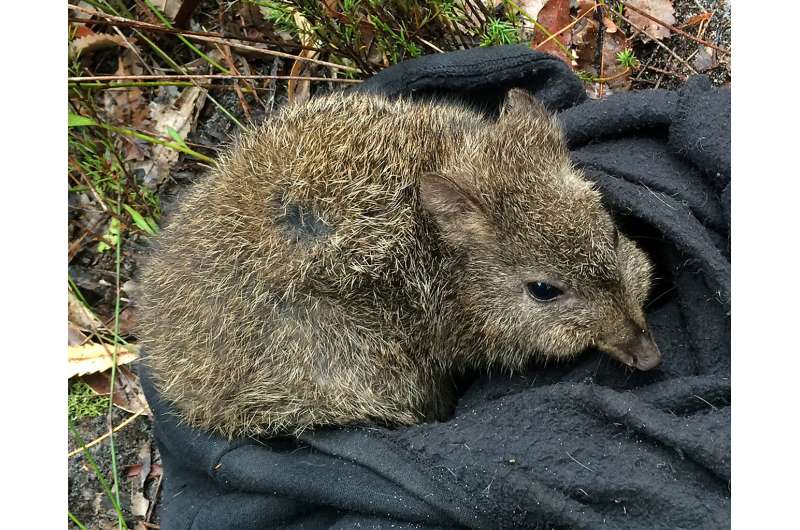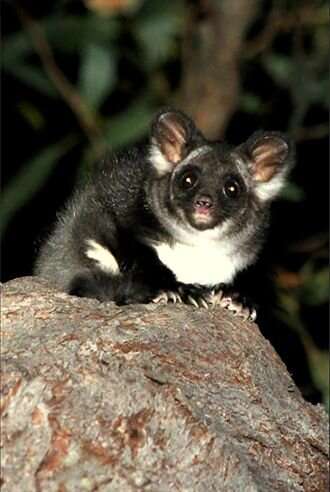Long-nosed potoroo. Credit: Dr Natasha Robinson
Drastic interventions in an ecosystem, like deciding whether to eradicate an unwanted species, can have unforeseen, and sometimes even undesirable, consequences on the rest of the species present in that ecosystem.
Just published research shows that, even if there is limited knowledge of these ecosystems, modelers should not wait any longer to start developing ecological forecasts that managers could potentially use to decide whether to implement such interventions.
The research, published in Ecology Letters, and led by researchers with the ARC Centre of Excellence for Mathematical and Statistical Frontiers (ACEMS), shows that despite their uncertainty, mathematical models can still be useful in informing management decisions.
"This is about moving the goalposts," said lead author Dr. Matthew Adams, a Research Fellow with ACEMS at The University of Queensland (UQ).
"In ecology, there has been this real concern that we can't use models for prediction until they are really, really good. But our analysis is saying to start using them for future predictions now. You might already get useful information out of them anyway. And they will only improve with time."
Dr. Adams compares the uncertainty in modeling ecosystems to how weather forecasts developed. People still relied on these weather forecasts, despite their uncertainty. They have continued to improve with time and more data, and ecological forecasts don't necessarily need to be as precise as weather forecasts.
The aim of using mathematical models is to predict what will happen to an ecosystem in response to many different scenarios.
In their study, the researchers looked at thousands of virtual ecosystems where everything about them was known. Using statistical analysis, they were then able to quantify the accuracy of their dynamic models fitted to datasets that might be obtainable in these ecosystems, and also provide a level of uncertainty in the models' predictions.
One example of a question a mathematical model might try to answer is whether management action is more likely to have a positive or negative impact on a certain species of interest.
Greater glider. Credit: Dr Chris McLean
"When we compared the models' answers to the true answer, more than 70 percent of the time the models were right," said Dr. Adams.
"That gives us the sense that even though we don't know exactly what's going to happen in the future, if we look at a species of critical interest and look to manage it, mathematical models might be able to help you decide whether a certain action is going to be good or bad for a species you care about."
This research project started with a week-long workshop at UQ in 2017, jointly funded by ACEMS and the ARC Centre of Excellence for Environmental Decisions (CEED).
"This work is the result of an idea proposed in that workshop. The conversations continued after we left, and allowed us to combine our complementary expertise in statistics, decision science, and ecological modeling to come up with new approaches to producing future predictions in these ecosystems," said Dr. Adams.
For now, the research looks at only small ecosystems.
"The next steps are to apply our models to real world examples: from Booderee National Park on Australia's eastern shores, to protecting an extremely rare species in the swamps of Western Australia, and guiding management of ecosystems on California's unique Channel Islands," said Dr. Adams.
"Models add to our tool kit for managing ecosystems, but they have their limits. Expert knowledge and monitoring data are unique aspects of that tool kit, and are also extremely valuable for improving models."
Dr. Adams says even if managers don't use the information from the models, it's important they have it.
"We should not be scared of using models," said Dr. Adams.
More information: Matthew P. Adams et al. Informing management decisions for ecological networks, using dynamic models calibrated to noisy time‐series data, Ecology Letters (2020). DOI: 10.1111/ele.13465
Journal information: Ecology Letters
Provided by ARC Centre of Excellence for Mathematical and Statistical Frontiers
























